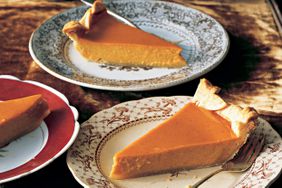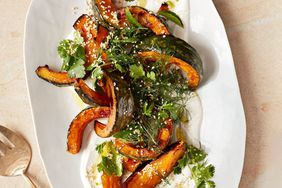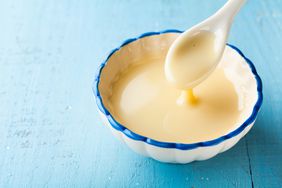:max_bytes(150000):strip_icc()/nutmeg-substitutes-getty-1123-8959803feda843f0a3612d8c976194af.jpg)
Westend61 / Getty Images
Next to cinnamon, nutmeg is one of the most popular spice rack staples in home kitchens, thanks to its distinct flavor and versatility. You can’t get through a holiday season without it, but it’s used for all kinds of recipes year-round. Nutmeg can add a pleasant finishing touch to bechamel sauce or give pumpkin pie its signature flourish.
If you realize you’ve run out of this spice, don’t worry. Whether you’re putting the finishing touches on a glass of holiday eggnog, flavoring a creamy custard for quiche, or enhancing the flavor of your favorite pumpkin dessert, these nutmeg substitutes are probably already common fixtures in your kitchen. Keep reading to learn how to make your spice cabinet work in your favor.
What Is Nutmeg?
Nutmeg is actually the inner part of a stone fruit, similar to an under-ripe peach or apricot, says Ethan Frisch, co-founder and co-CEO of Burlap & Barrel, a single-origin spice company. When the fruit is ready to harvest, the flesh splits open, revealing the bright red mace wrapped around the dark glossy shell containing the nutmeg. The fruits are hand-picked, the pits are removed and dried in the sun, and the shells are cracked open to reveal the "nut" inside.
Nutmeg is native to the Moluccas, a string of remote islands in modern-day Indonesia, says Frisch. It was grown exclusively in these islands up until the 1600s, when Dutch and British colonial interests invaded the islands and transplanted nutmeg trees throughout their other colonial holdings, including Zanzibar and Grenada, where Burlap & Barrel sources the majority of its nutmeg.
While there are many different nutmeg varieties, the ones that are most widely available tend to feature warm and sweet flavor profiles and unmistakably rich aromas.
When buying nutmeg, opt for whole pods instead of pre-ground spice. It will last longer and taste more fresh in your recipes.
Nutmeg Substitutes
Nutmeg has a distinct flavor that can be tricky to perfectly replicate, but don’t let that stop you from making a recipe if you don’t have any in your spice cabinet. Here is a list of other spices to use instead.
Mace
Mace and nutmeg both originate from the same plant. Nutmeg comes from the seed (or "nut") while mace is the outer membrane of that seed. Mace is the most similar in terms of flavor, although it is slightly stronger than nutmeg. It can be used as a 1:1 swap.
Ways to Use It: Mace is a great substitute for recipes that rely heavily on nutmeg as a major flavoring agent, such as eggnog or spiced cookies.
Mace’s flavor will dull more quickly than nutmeg, so it’s best to buy a fresh jar if yours is more than six months old.
Cinnamon
When it comes to baking, you’ll be hard-pressed to find a recipe that has nutmeg, but no cinnamon. These two spices tend to go hand in hand for all kinds of sweet treats. For most baking recipes, cinnamon is a safe substitute for nutmeg, but start off by using half the amount of cinnamon, as it has a much more pungent flavor.
Ways to Use It: Only the most distinct palates will notice nutmeg’s absence in spice-heavy recipes like pumpkin pie and snickerdoodles.
Ginger
Ground ginger comes from the dried ginger root, which leans more spicy than sweet. It’s often paired with sweeter warming spices like cinnamon or nutmeg, and adds a zesty flavor to both sweet and savory recipes. If using ginger in a sweet recipe, use about one-quarter of the amount of nutmeg it calls for. For savory recipes, use a 1:1 ratio.
Ways to Use It: Anything savory will benefit from a boost of ginger. It fits the bill anywhere nutmeg is traditionally used (things such bechamel sauce for pasta dishes or rich cream sauce to pour over a steak dinner).
When substituting fresh ginger for dried, 1 tablespoon of fresh grated ginger is equivalent to 1/4 teaspoon of dried.
Cloves
Ground cloves are a great substitute for nutmeg because they also have plenty of sweetness with a peppery undertone. Although similar, cloves tend to be a bit stronger than nutmeg, so use about half of the recommended amount when making the swap.
Ways to Use It: Consider substituting cloves for the usual baking suspects: cookies, pies, or anything with a chai flavor profile.
Allspice
Allspice can be used as a 1:1 ratio for nutmeg in both sweet and savory recipes. It has a slightly spicier flavor, reminiscent of a combination of nutmeg, cinnamon, and peppercorns.
Ways to Use It: Allspice is a common ingredient in many Jamaican recipes, so if one also calls for nutmeg, you can just use more allspice. It can also be added to the usual sweet suspects discussed above.
Pumpkin Pie Spice
Pumpkin pie spice is the one-size-fits-all ingredient in the spice cabinet. It can be used to swap out all of the warming spices in sweet recipes, since it is most commonly made with a combination of nutmeg, cinnamon, allspice, ginger, and cloves.
Ways to Use It: Anything pumpkin flavored! Swap out all of those spices for pumpkin pie mix in your next batch of pumpkin bread, pumpkin pie, or pumpkin cookies.
Black Peppercorns
Especially when combined with cloves, black peppercorns are a pretty deceptive nutmeg substitute. Swap ground pepper for about half of the recommended nutmeg in all of your savory recipes.
Ways to Use It: Use pepper in savory dishes that call for a touch of nutmeg, like bolognese sauce or spaghetti and meatballs.
Garam Masala
Popular in Indian and South Asian dishes, garam masala is a great finishing spice for savory dishes. Each region’s spice blend differs, but nutmeg is always included.
Ways to Use It: Use it in any sauce that calls for a pinch of nutmeg at the end. Or try it in lieu of the five spice powder in our pumpkin pie.








